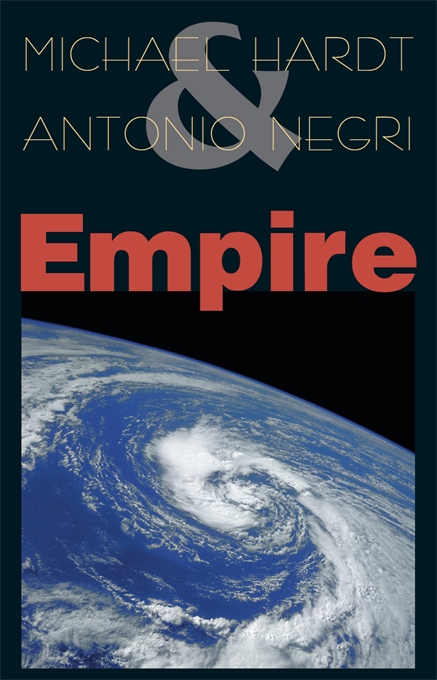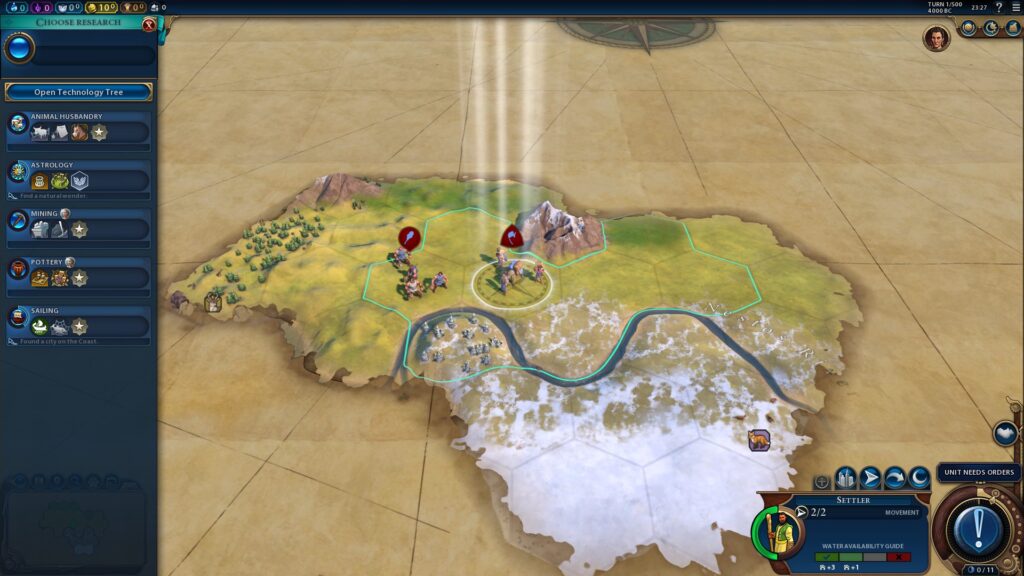This is a guest post by Daniel Navarro. Dan holds a MA in Media Studies from NYU Steinhardt and a BA in both Comparative Ethnic Studies and Religion at Columbia University. His research focuses on connecting theory and history to media, most often with games or music. He can be found on LinkedIn and on Twitter.
The year is 1918. Marseille, a small manufacturing city with plentiful oil and aluminum reserves, has recently been reinforced with an emergency flood barrier in case of a sea level rise, but the rest of France is in splendor. Neighboring Bordeaux is on its way to building a stadium and Paris, the capital, has recovered from the recent volcanic eruption. In all metrics except religion, France is dominant. Art flourishes and, with the invention of radios, French musicians will soon rule the airwaves. The early power play that Siam tried did not succeed in toppling the French Empire; in fact, Indrapura is now the heart of French culture with the Statue of Liberty, Broadway, and the Sydney Opera House all within walking distance. The appeal of the nation is so penetrating that Yerevan (of modern-day Armenia) is almost culturally French; they will certainly join the Empire soon and, after that, a cultural victory is all but assured. The United States has some impressive resources, but their technology is middling in comparison to their rivals in Scotland and thus will be no threat. France will have captivated the world and all without ever fighting an offensive war.
That was a succinct summary of an Atomic Era moment within the game Civilization VI, one of the most researched video game franchises in the field of historical game studies: Sid Meier’s Civilization.[1] The First World War had preoccupied the real world’s 20th Century France at the time, not some aspirations of global cultural hegemony. Why, then, does a franchise such as Civilization push a worldview in which nations (“civs”) compete with one another over cultural and technological advances? And why does Civilization VI borrow so much of its playbook from the hegemonic ambitions of empire-building in its core game mechanics?
In describing how Civilization’s systems work, I will refer to the definitions of empire presented by both dictionary sources and by Hardt and Negri as well as the concept of “hegemony” as theorized by Laclau and Mouffe.[2] The traditional view of modern empire is that of a nation, or metropole, with satellite colonial states. In Hardt and Negri’s book bearing the same name, Empire is a larger, extranational project, an extension of capitalism that is not geographically constrained. Religious, cultural, and diplomatic power are seen to operate in a nebulous fashion whereas military and scientific power is much more easily defined by borders and numbers. Laclau and Mouffe describe hegemonic control as an imperial power’s capacity to exert such influence that states often operate in ways counter to their own interests – the opening description of the power of the French Empire’s culture overwhelming that of Yerevan is a perfect example of where to find such hegemonic dominance in Civilization.
My argument is that Civilization VI has two trajectories of historical progress, that of resource mastery and that of hegemonic control, and gameplay presents a cycle of the two, where the gathering of resources can be utilized towards the establishing of control which then allows for the claiming of further resources. Victory conditions express the ideological framing at work and the routes towards those endings are just as interesting, with progress or governance remaining central to any understanding of Civilization as historical simulation of an empire’s route to dominance. Conflict between civilizations is assumed even in peacetime and, in fact, competition between powers is accentuated during peacetime, with resources being a key part of political maneuvering. Systems like Emergencies and the World Congress ensure that the game does not become an experience devoid of a cooperative form of competition, pitting foes against one another or leading nations to create new alliances. By the end, though, all other civilizations must defer in some way to the ultimate victor. In this article, I will explore Civilization VI and its adherence to the idea of hegemonic empire. Along the way, I will focus upon the role of the citizenry, the gathering of strategic resources, and the act of building up an empire.
I. The Citizenry
When the player loads a game of Civilization beginning in 4000 BCE: the player receives one settler, a civilian unit that creates cities instantly, and most often one warrior, a military melee unit that can attack or defend on adjacent hexagonal tiles. The placement of the first city in the game is a significant act. That first city, standing as the player’s Civilization’s capital, will expand its borders with the expansion of the nation’s culture, taking on more and more land under its borders. Early on, the map feels distinctly empty; perhaps there are cows or stone as “resources” that appear, but it takes time to develop the technology to see resources like iron or coal that might be near the player’s settlements or harvest that very stone after utilizing the civilian worker unit. From these early decisions, players can intimate the utilitarian role of the place of the citizens to the larger hegemonic project.
The workers themselves, though still formally present as a civilian unit, are notably absent. All forms of collective action seem to have been subsumed under state control. This is partly because ideology as an axis upon which nations might form alliances does not feature very heavily in the governance mechanics of Civilization VI, unlike in Civilization V. The “civics” mechanics, or governing legislations of a civ, are not specific to the player’s selection of government type. A democratic state can adopt the communist-styled Five-Year Plan civic, for instance. By the end, there are three main choices for governance: Digital Democracy with online direct voting, Corporate Libertarianism with power centralized in companies, and Synthetic Technocracy with AI assistance. Public opinion seems only to arise during crises: the lack of public services, military occupation, and moments of warfare, etc. This lowers the rate of production but otherwise has no effect upon the governing principles or actions of the state. In a sense, all governments are necessarily autocratic by nature of the player’s involvement – voting, technocracy, or corporate interest are just the veneer to the hegemonic mechanisms underneath.
The demands of the citizenry are not considered in terms of policy within Civilization VI. Where other games have party systems that show factions within government, the last game in the Civ series to include a similar concept was Civilization IV; even then, “factions” were more akin to random events than representations of political coalitions in the game, arising out of real popular demand. “The people” are shown to be excited about any change in governance, including changes in the type of leadership, and seem to accept these changes in the state’s structure without any period of dysfunctional rule (so long as a civic was researched on that turn). Civilization V included social revolutions that might affect the policy of one country based on the successes of a rival ideology in another – in Civilization VI, this mechanic has been replaced by the exertion of pressure from one civilization’s cities to another, reducing each other’s control over the population.
Taking these design factors into account, the hegemonic state of Civilization VI does not run the gamut of instability you might expect a game of this genre to. As the Ciompi Revolt or the many other popular impulses towards freedom detailed in Cohn’s Lust for Liberty have shown, a change in governance is not often met without a period of violence. Perhaps more critically, some level of domination must exist for the nation-state to exist at all.[3] Civilization IV and Civilization V have systems to gesture towards this, but the only place where the will of citizens comes up is either with reference to late-game policy choices (Music Censorship denies the civilian Rock Band unit from entering one’s borders) or as a population given to subversion via espionage (neighborhoods can spawn well-equipped dissidents that exist as “barbarians” mechanically).[4]
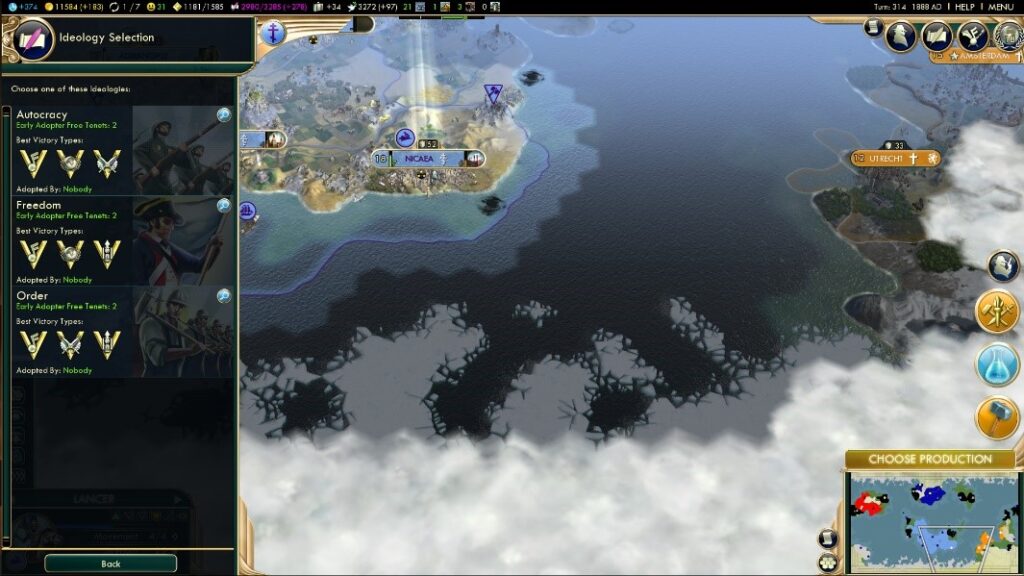
The most telling expression of hegemony in Civilization VI might be in its endgame, especially when analyzed as a Kojevean “end of history”.[5] Take, for example, the Science Victory, a path that has the player’s civilization colonizing a new planet. The end of the technology tree science has only tools for warfare, like a uranium-powered armored vehicle, and planetary escape as options. The largest and most industrially developed civilization has the advantage of controlling the pace of global warming. From the start of the game, certain terrain tiles display visual markers that if sea levels were to rise, these would sink under the ocean. Any resources or buildings on these titles would therefore be lost in the event of rising oceans. The only counter to this is with the flood barrier technology, but this improvement is only available in the nuclear era; civilizations that fall behind are thus completely helpless. If the currently-dominant civilization has little to lose from global warming and is willing to suffer the stronger natural disasters, it can simply allow the ecological disaster to come to pass (even more so if the player has prepared a response to it beforehand). The hegemon is therefore in many ways immune to the negative effects of its domination, where other competing civilizations might struggle.
There is no winning possible without keeping up with whichever power is the most scientifically advanced or possesses the most strategic resources. The end of the culture tree is related to recovering from humanity’s own mistakes, with options like carbon dioxide recapturing and seasteading districts to prevent them from being destroyed by rising sea levels. This has the net effect of making Civilization VI a tale of survival after the proverbial storm more than a triumphant leap into the future. In online discussion about late game scenarios and strategies, the acquisition of late-game resources remains critical to any type of victory. Without strategic resources such as oil, aluminum, or uranium, a modern state is simply unable to function effectively in its military endeavors and cannot reach the same peak of cultural development. This feeling of “unfairness” is something that I believe is intentional in the game’s design – in other words, the mechanics seem to point to keeping a competitive edge at a geopolitical level. It is a tale of haves and have-nots, where those in the lead dictate the pace at which others have the potential to advance. The triumphant ending screens seem subtly bleak with all this in mind. What is clear to me is that the rest of the world’s “players” must dance to the tune of the victor in exactly the sort of exploitative relationship that Laclau and Mouffe defined in Hegemony and Socialist Strategy. In a competitive game, most victories will always come down to two things: resources and control.
II. Gathering Resources
Civilization’s systems follow a positivist reading of history, laid out in tree-like diagram formation of interconnected technologies. In this framework, every invention is a prerequisite for another “more developed” technology. Technological development is laid out linearly, one invention after the other; the first spear is thus distantly related to the Anti-Tank Crew, both belonging to the “anti-cavalry” class of unit.[6] Resources appear on the map in the course of progressing through the game’s technology tree, a sort of prerequisite system that has bronzeworking reveal the presence of iron and industrialization reveal the presence of coal, for instance. In the same vein, the first workshop in the Industrial District is the direct predecessor of coal-burning power plant. This is something that is deterministic and teleological, almost reminiscent of Ray Kurzweil and his Singularity, where every advancement leads towards some unforeseen “end of science” and “end of culture” that looms inevitably in the future.[7]
In truth, the existence of these resources was absolutely known to prior civilizations. Oil from whales were utilized for lamps, offering some extra production in the game, showing some knowledge of how such a fuel could be used.[8] Asphalt, a by-product of crude oil, had been used as “a waterproofing agent” as early as civilization itself.[9] Coal has been mined in England for millennia, known to the Romans who occupied Britannia[10]
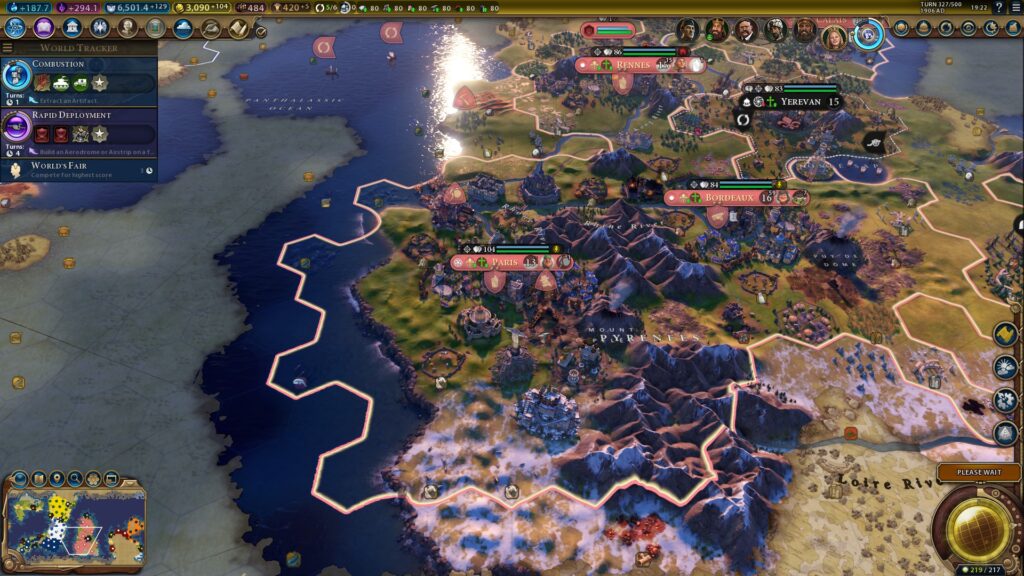
This is all to show that these resources would not be hidden as much as not fully capitalized on; Civilization reveals these resources when they become tactically relevant as localities of power and control for the hegemon to compete over with other aspiring empires. Here, Civilization mirrors the utilitarian perspective of Seeing like a State, expressed by James C. Scott’s book of the same name.[11] (For further reading relating Seeing like a State and games on Play the Past, examples can be seen here and here.) Niter appears when riflemen and cannons can be built, and aluminum appears when fighters and bombers can be built. For one, this centers the military use of these resources over their civilian use. This resource mechanic creates incentives for in-game colonization; expansion into territory with these resources rendered visible before others can perceive them provides a competitive advantage for the civilization that seizes upon their ability to identify the most recent strategic resource.
It is by profiting off uneven access to resources, whether economic, cultural, military, or otherwise, that one can push toward victory and control. The scarcity of raw materials further exacerbates this power gap. Resources that are improved upon by a worker unit take time to build up into the nation’s reserve and are then expended upon producing or upgrading an existing unit. Having more available mines of aluminum, for instance, allows a nation to build up their reserve much faster than they otherwise would. In practice, this means that building planes would be much faster for a nation with greater access to the resource; logistics can, in some very meaningful ways, affect the outcome of a war based solely on how quickly resources can be acquired and processed. Upgrading a unit makes them outclass those of the prior era, making conflicts against civilizations still using older types of units unbalanced, as they would in asymmetrical warfare. Already, a historical theory becomes clear: making the field imbalanced and creating situations like the Battle of Agincourt (i.e., the alleged superiority of the English longbow over French armored cavalry) is how a player gains an advantage over other Civs.[12] New technologies and new resources make fielding the old impossible if the hegemon wishes to continue its expansion, and that remains true throughout 6000 years of in-game time.
III. Hegemonic Domination
Reviewing some of the many ways that resources can be “leveraged”, perhaps the simplest is through military conquest, establishing hegemony through state violence. The might of the player’s military is unrelated to the growth of culture or population, based completely upon seeking out and accessing resources while using production to create more units. These standing armies can be very expensive and, in the longer term, having no trading partners will ruin the player’s economy, decreasing their scientific output and, eventually, losing their units to attrition and cities to rebellion. Military units, then, are unimportant for internal affairs in and of themselves; they are unnecessary for enforcing law or pacifying the population of one’s own civilization until the player encounters another civilization, as a sort of “Hobbesian ‘God on earth’” that maintains social order.[13] These forces can be trained against masses of cultureless barbarians that attempt to raid the civ’s land or steal away their workers and settlers before retreating into the “fog of war”.
From the point of meeting a new rival, the competition for region hegemony puts pressure on cities to develop both culture and religion, as extra-military pathways to enforcing hegemonic ambitions. The higher the population of a city, the more influence it exerts upon another owned by a rival. This process can eventually lower a city’s loyalty to the point that it rebels and, potentially, might wish to join another civilization. The very existence of a large city thus exerts a soft cultural power over the region, analogous to how religion spreads “passively” (i.e., without player activation) over trade routes within the game. This soft power is what will, eventually, help a civilization evolve into the hegemon. For now, soft power influence forces other civilizations to settle further away or risk their city being overtaken, subsumed into a fledgling empire. For Eleanor of Aquitaine’s France, this power grows stronger with cultural artifacts called “Great Works”; for all practical purposes, this means that any city that falls under a certain threshold of loyalty is immediately absorbed into the French Empire. As for religion, converting a city, often using civilian units called Apostles or Missionaries, increases the pressure exerted on other cities, slowly making it harder to reconvert those cities and, eventually, making the rival religion impossible to spread by seizing their holy cities.
Civilization VI’s soft power mechanics imply that it is culture that defines a state’s influence over space, a shared sense of identity not unlike Kojève’s idea of a modern Latin Empire.[14] “[T]he physical territory and population were conceived as the extension of the transcendent essence of the nation” to quote Empire.[15] Even a diplomatic victory becomes a zero-sum race for a limited number of points that cannot be shared between nations. Only one civilization can succeed in uniting the world, even if all the others might also be trying for the same. There is only one Secretary General of the United Nations-like position; no matter one’s feelings on the matter, diplomacy in Civilization VI becomes a battle of prestige and control like any other.
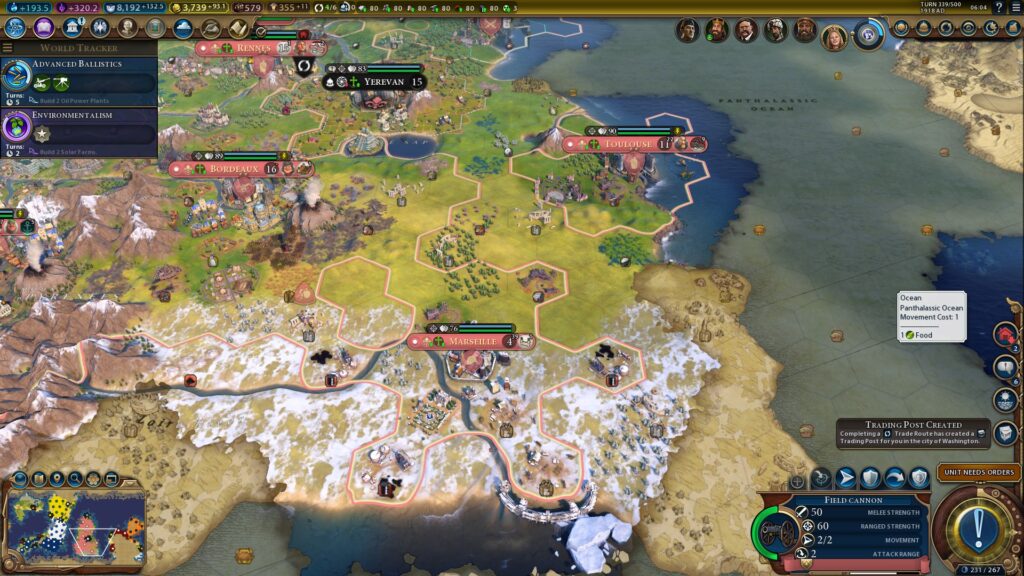
Statecraft, then, is a balance of yields and resources to disallow being outpaced by rivals, a numbers game which is summarized neatly at the top left of the player’s screen. These include science, culture, faith, gold, tourism, diplomacy points, trade routes, amenities, happiness, housing, and more. It is through these metrics that a successful ruler can be differentiated from a struggling one and in the balance of these “vital statistics” that a player accomplishes any semblance of stability. Without this balance, it becomes unfeasible to defend against a stronger military or impossible to prevent one’s culture from being overtaken. What this inevitably leads towards is the framework put forth by Samuel Huntington’s The Clash of Civilizations and the Remaking of World Order; nations strive to be major power players on the world stage and ideology is overtaken by cultural difference as the point of conflict between nations.[16]
The constant cycle of acquisition and utilization of resources is the main thrust of Civilization VI’s depiction of historical progress. “Progress” is reduced to a competition over achieving hegemonic dominance, written through six-thousand years of human history, with horses being the first strategic resource for war and uranium being the last. Even peaceful methods of victory require these things; coal, oil, and uranium remain the more accessible fuels – alternative fuels like wind and solar only gain traction as resources through late-game science developments and, even then, wind and solar cannot solve the issue of military parity. Despite its rich narrative tapestry, the framing premise of Civilization VI remains the saga of empires. Attempting to run counter to this fundamental game logic may well allow a competing civilization to surpass and outmaneuver your own.
[1] Chapman, Adam, Anna Foka, and Jonathan Westin 2017; Sicart 2013.; Negri and Hardt 2000
[2] Negri and Hardt 2000; Laclau and Mouffe 2001; Laclau 2005
[3] Cohn 2008
[4] A similar state-building game like Paradox’s Europa Universalis IV better represents the task of ensuring the stability of a population, though that game focuses from 1444 CE to the early 19th century, allowing it to narrow its focus on mechanics that better serve those years.
[5] Kojève defines the “end of history” as the end of the animating struggle of Man against himself from his reading of Hegel (Roth 1985).
[6] Gyhs 2012
[7] Slocombe 2019
[8] Phillips 2006
[9] Abraham 1938
[10] Freese 2003
[11] Scott 1998
[12] Martinez 2020
[13] Negri and Hardt 2000
[14] Kojève 1945
[15] Negri and Hardt 2000
[16] Huntington 1996

